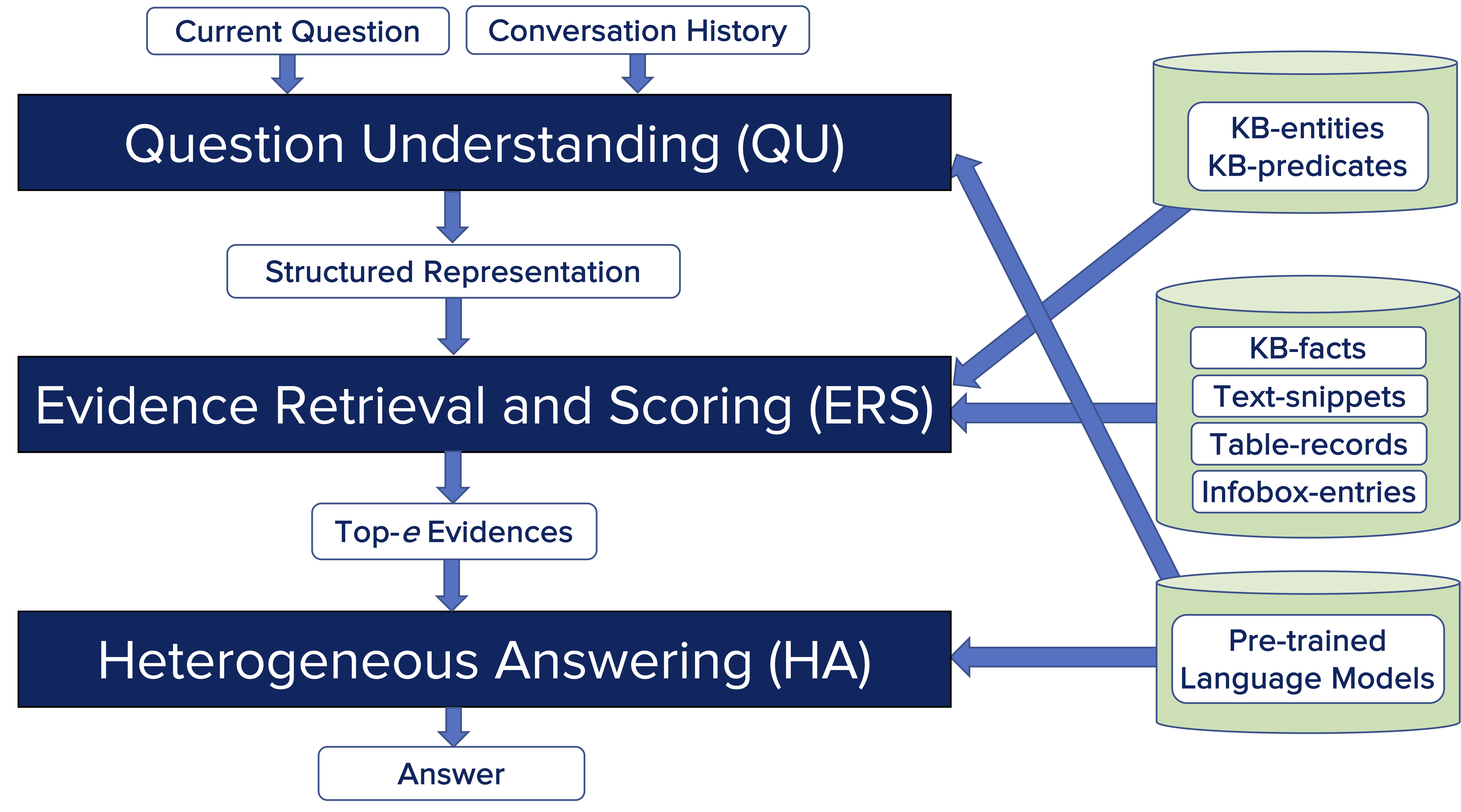CONVINSE
This page is on the 2022 long paper on Conversational Question Answering on Heterogeneous Sources. We provide an extended video as an introduction to the work (a shorter video is also available here).GitHub link to CONVINSE code Directly download CONVINSE code
Demo
Description
Conversational question answering (ConvQA) tackles sequential information needs where contexts in follow-up questions are left implicit. Current ConvQA systems operate over homogeneous sources of information: either a knowledge base (KB), or a text corpus, or a collection of tables. This paper addresses the novel issue of jointly tapping into all of these together, this way boosting answer coverage and confidence. We present CONVINSE, an end-to-end pipeline for ConvQA over heterogeneous sources, operating in three stages: i) learning an explicit structured representation of an incoming question and its conversational context, ii) harnessing this frame-like representation to uniformly capture relevant evidences from KB, text, and tables, and iii) running a fusion-in-decoder model to generate the answer. We construct and release the first benchmark, ConvMix, for ConvQA over heterogeneous sources, comprising 3000 real-user conversations with 16000 questions, along with entity annotations, completed question utterances, and question paraphrases. Experiments demonstrate the viability and advantages of our method, compared to state-of-the-art baselines.
Contact
For feedback and clarifications, please contact: Philipp Christmann (pchristm AT mpi HYPHEN inf DOT mpg DOT de), Rishiraj Saha Roy (rishiraj AT mpi HYPHEN inf DOT mpg DOT de) or Gerhard Weikum (weikum AT mpi HYPHEN inf DOT mpg DOT de).To know more about our group, please visit https://www.mpi-inf.mpg.de/departments/databases-and-information-systems/research/question-answering/.
Download ConvMix
Training Set (1680 Conversations) Dev Set (560 Conversations) Test Set (760 Conversations) Please check out CompMix, our new dataset for heterogeneous QA, collating the completed versions of the conversational questions in ConvMix. The ConvMix and CompMix benchmarks are licensed under a Creative Commons Attribution 4.0 International License.
ConvMix Leaderboard
| Model | P@1 | MRR | Hit@5 |
|---|---|---|---|
|
PRAISE Kaiser et al. '25 |
0.620 | 0.665 | 0.746 |
|
UniHGKR-7B Min et al. '24 |
0.465 | 0.514 | 0.562 |
|
Mistral-7B + Graph + Memory Jain et al. '24 |
0.445 | - | 0.512 |
|
EXPLAIGNN Christmann et al. '23 |
0.406 | 0.471 | 0.561 |
| CONVINSE (top-k FiD) | 0.343 | 0.378 | 0.431 |
|
CONVINSE Christmann et al. '22 |
0.342 | 0.365 | 0.386 |
|
Question Resolution Voskarides et al. '20 + BM25 + FiD |
0.282 | 0.289 | 0.297 |
|
Question Rewriting Raposo et al. '22 + BM25 + FiD |
0.271 | 0.278 | 0.285 |
What do conversations in ConvMix look like?
The sources in square brackets are the ones the respective answer can be found in.
How was ConvMix created?
The ConvMix benchmark was created by real humans, and we tried to ensure that the collected data is as natural as possible. Overall, it contains 3,000 conversations with 16,000 unique questions. Master crowdworkers on Amazon Mechanical Turk (AMT) selected an entity of interest in a specific domain, and then started issuing conversational questions on this entity, potentially drifting to other topics of interest throughout the course of the conversation. By letting users choose the entities themselves, we aimed to ensure that they are more interested into the topics the conversations are based on. After writing a question, users were asked to find the answer in eithers Wikidata, Wikipedia text, a Wikipedia table or a Wikipedia infobox, whatever they find more natural for the specific question at hand. Since Wikidata requires some basic understanding of knowledge bases, we provided video guidelines that illustrated how Wikidata can be used for detecting answers, following an example conversation. We provide not only the question and answer, but also the answer source the user found the answer in, a paraphrase, a completed question, and question entities. For further details on ConvMix, please refer to the paper.Paper
"Conversational Question Answering on Heterogeneous Sources", Philipp Christmann, Rishiraj Saha Roy, and Gerhard Weikum. In SIGIR '22, Madrid, Spain, 11 - 15 July 2022.[Preprint] [Code] [Poster] [Slides] [Video] [Extended video] [User study]